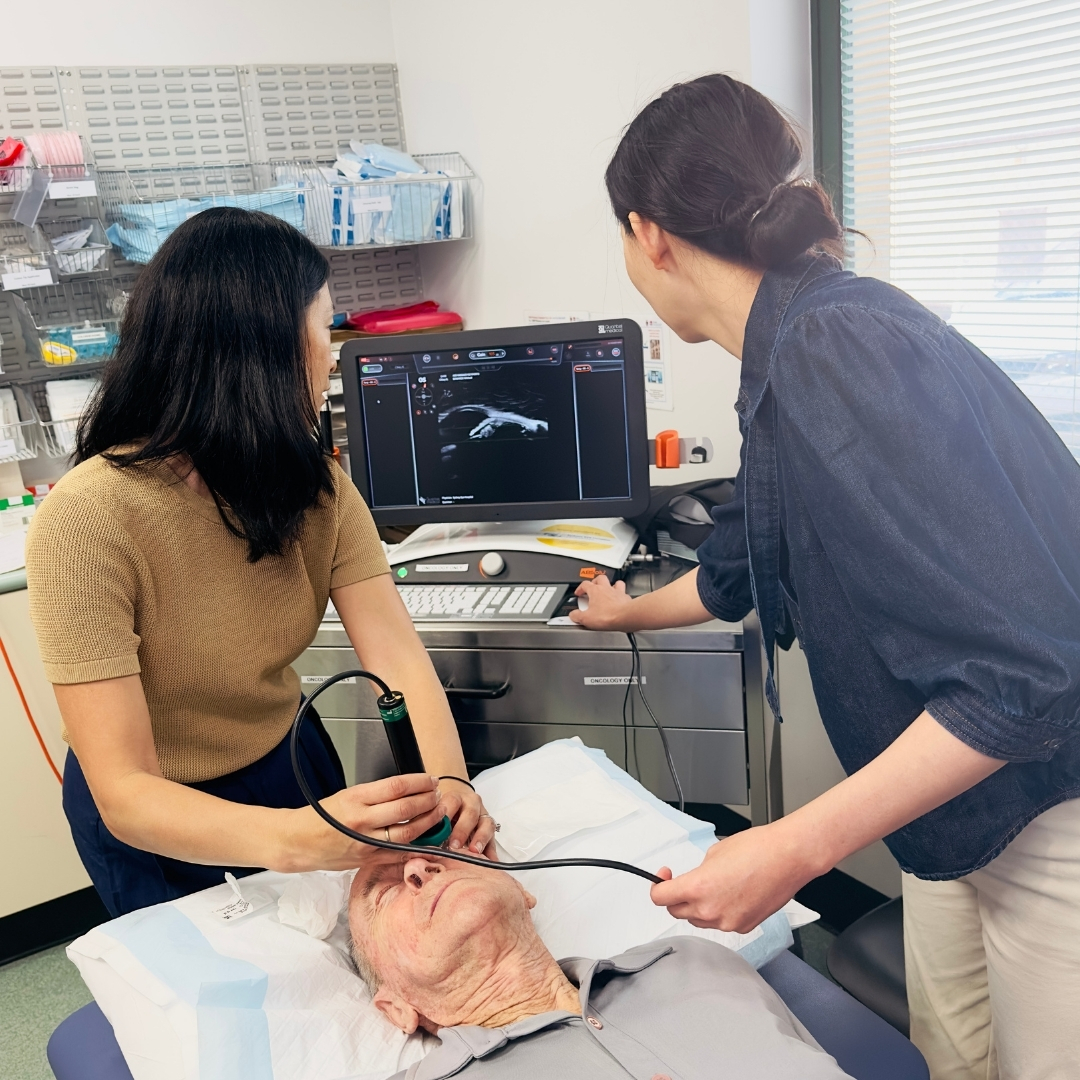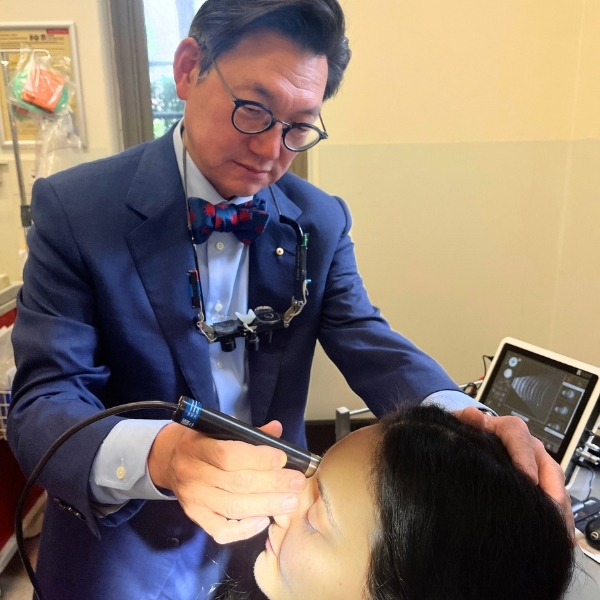This Glaucoma Week we’ve asked our expert glaucoma specialist, Dr Ridia Lim, to share the latest in surgical options for patients. Dr Lim has reviewed developments in glaucoma surgery as well as older surgical techniques that are still key in treating glaucoma today.

Dr Ridia Lim, pictured left, with Glaucoma Fellows
Dr Kalliopi Giannopoulou and Dr Aaron Wong in 2023
There has been a rapid evolution of glaucoma surgery in the past two decades, leading to an ever-increasing array of treatment options.
Dr Ridia Lim, Head of the Glaucoma Unit at Sydney Eye Hospital explains that the aim of all glaucoma surgery is to lower the eye pressure and that this is the only proven way to stop glaucoma from getting worse.
“The surgical treatments available to patients are expanding rapidly as we search for surgeries that are safer and that work well to lower eye pressure, even in early to moderate glaucoma stages of the disease,” she says.
“To lower eye pressure, most glaucoma surgeries create a new drainage pathway for internal eye fluid or improve drainage of internal eye fluid through existing outflow channels. Some of these surgeries use implants,” she says.
While it is good to understand the various options available, anyone considering surgical intervention to treat glaucoma should follow the advice of their chosen specialists.
“Many factors must be taken into consideration when determining the best glaucoma treatment option for an individual, such as age, severity of glaucoma, progression of disease and other health factors,” says Dr Lim.

City Sydney flags in Martin Place encouraging people to
get their eyes tested this Glaucoma Week
Trabeculectomy
Despite being first performed over 50 years ago, trabeculectomy remains the benchmark glaucoma filtering operation. This operation can be performed in most uncontrolled glaucoma cases. The aim of this operation is to create an outflow drain made of the patient’s own tissues, to create a “bleb”, a fluid filled drainage area on the eye surface, under the top eyelid. The operation has evolved over time to make the surgery safer and more effective. This operation takes at least 3 months of follow up to maximise a successful outcome. The main challenge with any glaucoma drainage surgery of this group is scarring and strong anti-scarring medications are required at the time of and sometimes, after the surgery. Trabeculectomy and other glaucoma filtering surgeries can reduce eye pressure dramatically and take the place of multiple glaucoma eye drops. However, it is important to remember that no operation cures glaucoma.
Deep Sclerectomy
Deep sclerectomy is another variation of the glaucoma filtering operation, using the patient’s own tissues. This operation is comparable to trabeculectomy from the patient’s perspective. A bleb is formed and 3 months of careful follow up is required for success. The main difference with trabeculectomy is a variation in the surgical technique. From a patient perspective, it is like trabeculectomy.
Preserflo MicroShunt
The Preserflo Microshunt operation is another way of creating a glaucoma drain. Like trabeculectomy, it produces a drain made of your own tissues- a bleb. Unlike trabeculectomy, it uses a short tube made of a very biocompatible material (SIBS) to shunt the fluid from the eye to the bleb.
Preserflo was introduced in Australia in 2022 and global experience is increasing. Surgeons would generally use the Preserflo similarly to a trabeculetomy. An eye that is suitable for a trabeculectomy would generally be suitable for a Preseflo, unless very low target eye pressures are required. The recovery period after Preserflo may be faster than with trabeculectomy or deep sclerectomy.
Xen Gel Stent
Like the Preserflo, the Xen gel stent is a short tube. It is made of gelatin and designed to be implanted inside the eye. It creates a bleb as well. The Xen gel implant can be inserted without cutting the surface “skin” of the eye, the conjunctiva. The results of the Xen implant are similar to Preserflo and the recovery is often fast as well. Like trabeculectomy, further procedures may be required after the surgery to ensure the success of implanting devices such as the Xen and Preserflo.
Glaucoma Drainage Devices
When glaucoma filtering surgeries have failed or are likely to fail, drains can be made using an implant to form the drain. Glaucoma drainage devices have been used since the 1960’s and there are now several different models of these devices available in Australia: Baerveldt, Paul and Molteno implants. They have a silicone plate that creates the bleb and a tube that goes into the eye. They are effective and are used extensively in advanced glaucoma. Like trabeculectomies, they require 3 months of intensive follow-up.
iStent
The iStent is a trabecular micro-bypass device made of titanium. It has been available for more than 10 years and is the most widely implanted trabecular micro-bypass device worldwide. This implant, like other trabecular bypass devices connects the eye to its own outflow channels. It is implanted alone or with cataract surgery. It goes into the front of the eye, into an area called the angle of the eye. The wall of this angle is called trabecular meshwork, and it is the passageway into the eye drain, the Schlemm’s Canal. By bypassing the trabecular meshwork, it reduces the resistance to normal outflow. The implant is safe and effective. Its effect is similarly to using one or two glaucoma eye drops.
Hydrus Microstent
The Hydrus microstent is a trabecular stent made of nictinol (titanium, nickel alloy). It is designed to be implanted into the angle of the eye (inside the front chamber of the eye), like the iStent, through the trabecular meshwork into Schlemm’s canal. It is a longer stent and sits inside the natural eye drain, the Schlemm’s canal. The design allows it to bypass the normal outflow (trabecular meshwork) and to augment natural drainage by dilating the Schlemm’s canal for about the same length as an eyelash.
iTrack Ab-interno Canaloplasty
The iTrack canaloplasty is an operation that aims to improve the eye’s natural drainage system by dilating the natural drainage, the Schlemm’s canal. It uses a microcatheter with an illuminated fibreoptic tip. This is inserted into the front chamber of the eye and inserted into the natural drain via the trabecular meshwork. Then the device delivers a gel directly to Schlemm’s canal to dilate the natural eye fluid (aqueous) drainage system. Early data has shown positive results, and more data is currently being collected.
Gonioscopy-Assisted Transluminal Trabeculotomy
Gonioscopy-assisted transluminal trabeculotomy has been around for about 10 years, although it has come to Australia more recently. It also targets the same area as iStent and Hydrus stents, but it does this without leaving a device implanted. A stitch or an iTrack microcatheter is used to enter the Schlemm’s canal via the trabecular meshwork as for the iTrack Cananoplasty but then the lining of the drain, the trabecular meshwork, is cut for either 180° or 360°. All the trabecular drainage augmentation procedures, with or without a device, are associated with more internal bleeding, although it is mostly a transient issue.
Miniject
The Miniject is an implant made of a soft, porous, flexible and biocompatible material (STAR). It is inserted into the eye drain area as well but into a different outflow pathway known as the suprachoroidal space. This space is usually not open, but the Miniject is able to open it. It creates an effective eye fluid drainage outflow by opening this potential space and lowers the eye pressure. It is a promising device but is still relatively new to the market and research is being done to collect information about its effectiveness and long-term safety. It is the only device currently available that channels fluid into this area.
Implantable Drug-Eluting Devices- iDose
Injectable glaucoma medications are on the horizon but not currently available in Australia. The iDose is one of the possible candidates that we might see in the market in the next few years.
The iDose is a biocompatible titanium implant containing a stored supply of travoprost (a pressure lowering drug). It is designed to be implanted into the eye, like an iStent, into the trabecular meshwork and once implanted, it slowly releases the drug over many months. Thereby the drug effect is achieved for a long period without the patient taking the eye drop. The iDose and others like it have the potential to change how we treat glaucoma. Glaucoma surgery has generally followed failure of medications and laser, however, when implantable medications become available, we are likely to offer this type of surgery much earlier in the glaucoma journey. It also would mean that patients may not need to take an eye drop and potentially will have fewer side effect of treatment.
All glaucoma treatment in the long-term is aimed at giving the patient the best vision related quality of life and we are making progress in that direction.
Some of the content from this article was originally published in Mivision issue 193, September 2023 “Surgical management of Glaucoma in 2023: What’s new and what’s still working”.









